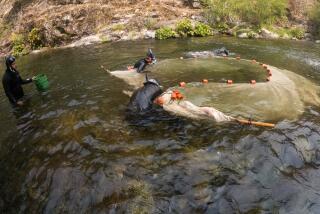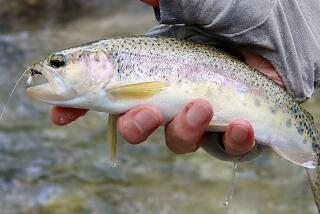EAGLE LAKE : These Trout Are Not Only Tougher, They Are Better
- Share via
SUSANVILLE, Calif. — When the fish are in Pine Creek, there’s no time to waste.
“I was down working on my Jeep Sunday when Ernie (Spalding) called and said, ‘Hey, there are fish running,’ ” Laird Marshall Jr. said. “So we were up here Monday bright and early.”
With their rods and flies?
Hardly. Fishing at nearby Eagle Lake doesn’t open until the Saturday before Memorial Day--May 26 this year. Spalding, whose ancestors helped to settle the area of the lake in the mid-19th Century, is a Lassen County sheriff for the Eagle Lake substation. Marshall is assistant manager of the state’s Crystal Springs Fish Hatchery 65 miles away.
Each spring, at the first hint of a thaw, Marshall eagerly awaits Spalding’s call.
“He usually doesn’t call when the creek runs,” Marshall said. “He calls when the creek is running with fish. “
That means the Eagle Lake rainbow trout are trying to spawn.
The situation is always critical. No other game fish has shown it can tolerate the high alkalinity of Eagle Lake, and yet there is no adequate spawning area. This year, the creek--the lake’s only significant inflow--ran only three weeks. Two years ago, it ran only four days.
The trout, driven by instinct, don’t know that even if they managed to lay their eggs and escape before the creek ran dry, their fry would never survive. That’s why for more than 30 years the California Department of Fish and Game has played midwife.
As they head upstream, the fish find their way blocked by a 3-foot-high weir, with flat board fingers extending to prevent their leaping the falls. Instead, they are diverted into a trap along one side and milked of their eggs and sperm, which are transferred to the hatchery. The biggest and best of the spawners go back into the lake, to be rejoined by some of their offspring a year later.
Others go to other Northern California lakes, where they are prized for their hardy nature. There are about 100,000 Eagle Lake fingerlings at Fish Springs Hatchery in the Eastern Sierra waiting to be planted late this summer in troubled Crowley Lake as sub-catchables.
Especially around Northern California, Eagle Lake rainbows are special. They are selectively planted at about three-quarters of a pound and, thriving where other fish would fail, they grow to two pounds in one year, to three pounds in two years.
They’re large enough that the lake limit of three--two fewer than the new statewide limit--seems fair. Six-pounders are caught often, 12-pounders occasionally. Catches averaged 16 1/2 inches on opening weekend last year. The best fishing is over the underwater springs that replenish the lake.
Also, in “California Trout” by Jim Freeman, the author writes: “The Eagle Lake trout are deep-bodied and the flesh is both firm and fine-grained, making them some of the best eating trout in the world.”
Essentially, they are still “wild” fish. They just took a detour through a nursery.
Doc McCormack, manager of the Crystal Springs hatchery, said: “Basically, that’s a brood pond for us. We put the fish back in there. They grow up to brood fish, and then we spawn ‘em. We’re just doing what nature is unable to do.”
Nature has always had its capricious way with Eagle Lake. Its level fluctuates constantly, and the fishing has been diversified, if not always bountiful.
The lake lies in a volcanic region at 5,100 feet on the east side of Lassen National Park. According to the book “Purdy’s Eagle Lake” by local historian Tim Purdy, after an earthquake initially dropped the level two feet in 1889, over the next several years it gradually rose to its highest historic levels, until man intervened.
The lake has no natural outlet, but in 1923 a developer, Leon Bly, built an irrigation tunnel that took the lake to its lowest level over the next 12 years. Until then, the lake was known for truckloads of trout, and largemouth bass did well for a time, but attempts to establish populations of browns, silver salmon and other species failed. Finally, the alkalinity increased as the lake level dropped, and the bass were unable to reproduce, totally disappearing.
Finally, in November, 1986, after many years of financial problems and water rights disputes, the Bureau of Land Management had the tunnel sealed, and Eagle Lake’s latest comeback seems hindered only by the continuing statewide drought.
With a pH alkalinity factor of between nine and 10 (seven is neutral), only the Eagle Lake trout remain, sharing the lake with non-game tui chub and Tahoe suckers. And the trout were barely hanging on when the DFG took a renewed interest in the 1950s.
Marshall said: “Historically, they think the only way the fish stayed in this stream and in the lake was that they stayed in the upper reaches of Pine Creek that never dries up. Then, in good water years, their offspring would replenish the lake.”
In 1956, the DFG took a half-dozen of that original stock, spawned them artificially and subsequently planted about 3,000 offspring back into the lake. In 1958, the project sped ahead with the construction of the fish trap and egg-collecting station.
This spring, the U.S. Department of Agriculture declared an “extreme drought” condition for the region. One or two launching ramps may be unusable, and the water may warm earlier than usual, but the fishing should still be good.
The creek ran strong enough and long enough that DFG workers collected 1.1-million eggs--10% more than their goal--which they expect will result in about 850,000 fish, allowing for attrition.
About 200,000 of the largest will be recycled into Eagle Lake next year.
“The small fish don’t come (back) here,” Marshall said.
The DFG also has some insurance.
“We’ll selectively spawn some of the larger fish, and those eggs will be specifically earmarked for a broodstock program at Darrah Springs Hatchery and raised there until about six months prior to spawning,” Marshall said. “Then they’ll be transferred to Mt. Shasta Hatchery and spawned.
“That’s our backup if the whole fishery in this lake falls down. We have Eagle Lake trout in the hatchery system, either coming up as catchables or future broodstock.”
The DFG intends to keep Eagle Lake for Eagle Lake trout.
Don Weidlein, DFG supervising fishery biologist for northeastern California, said the alkalinity is “extremely high and higher than most trout can survive in . . . (but) I think other fish would probably survive, particularly as water quality improves in the future, which it should do with the sealing of the tunnel.
“I would suspect that Lahontan cutthroat would survive better than Eagle Lake trout, based on work we have done elsewhere.”
In one project at Indian Tom Lake, cutthroat survived, but Eagle Lake trout didn’t--although Weidlein points out that other water quality factors also could be important. His greatest fear is that someone might illegally introduce bass back into the lake, upsetting the delicate balance.
“It would be a disaster for the trout fishery,” he said.
During the spring run, a DFG employee lives in the small shack on a bluff above Pine Creek, near the fish trap. If the stream flow varies, he must adjust the flow through the trap accordingly to avoid losing any fish. At least once this year, the attendant, Al Johnson, had to get up at 2 a.m. to do it. As it was, of 475 fish handled this year, only five failed to survive the stress of the operation.
One day this spring, Marshall and Johnson were working in the enclosed streamside chamber where the diverted flow brings the fish into tanks the size of wash tubs. Marshall held while Johnson squeezed. Gently. The eggs oozed into a pan. Then Johnson squeezed a male over the eggs to fertilize them.
Periodically, DFG assistant Dottie Mason took a pan and poured it into a milk can. Soon there were enough cans in the pickup truck to start the 1 1/2-hour ride to the hatchery.
These eggs were in the tender “green” stage. At the hatchery, they were ladeled into incubator trays, where they were kept until reaching the more stable “eyed” stage, when the dead ones could be eliminated. In about 32 days they hatched.
In 56-degree water, Marshall said, some domestic broodstock will hatch in 22 or 23 days, but the water temperature at Crystal Springs is only about 48, “so that slows ‘em down.”
That’s OK. There’s no hurry, at least until next year.
More to Read
Sign up for Essential California
The most important California stories and recommendations in your inbox every morning.
You may occasionally receive promotional content from the Los Angeles Times.










